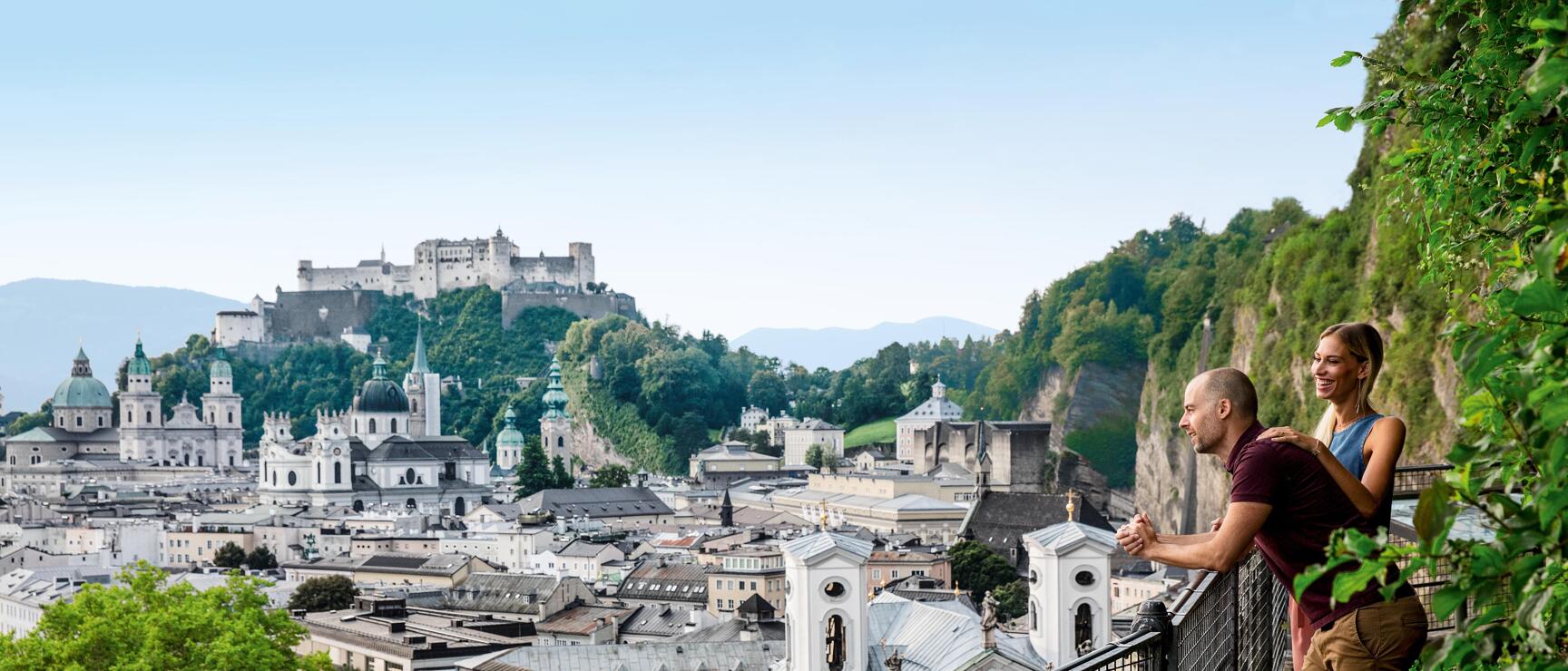
Time out on the Mönchsberg in Salzburg
A relaxing walk in the greenery above the rooftops of the old town
The people of Salzburg hold their local mountains dear, especially the Mönchsberg. For children, a walk here feels like a little adventure: In winter, small hills provide perfect spots for sledging, while in summer, secret paths, mysterious caves, and thrilling lookouts transform the Mönchsberg into a giant playground. In spring, the delicate leaves of beech, sycamore, linden, and oak trees drape the entire mountain in a fresh green shimmer. Come autumn, the trails lead through a fiery sea of colourful leaves.
There are several ways to reach the Mönchsberg. One recommended route starts on the right bank of the Salzach at Imbergstraße. An avenue of ancient, gnarled plane trees lines the riverside promenade, with the gentle flow of the Salzach on one side and the world-famous silhouette of Salzburg on the other: colourful townhouses, the Salzburg Cathedral, and the Hohensalzburg Fortress. What a view!
Walk along the Mönchsberg, part 1
"Mozart's Hood" and beautiful sounds
In Salzburg, the traces of famous personalities can be found at almost every turn. One of them—perhaps the greatest—has bridges, squares, alleys, and monuments dedicated to him. On your way to the Mönchsberg, you’ll cross the Mozart Steg, step into the Old Town, and pass Mozartplatz and its statue of the great composer. Here, the genius loci is ever-present. Next comes Residenzplatz, a grand square that once showcased the splendour of the prince-archbishops, located directly by the Cathedral.
To make the most of your trip to the Mönchsberg, consider timing it so you’re at one of the viewpoints at exactly midday. This is when the Cathedral’s bells chime, offering one of Austria’s most beautiful bell sounds—a tradition with a fascinating history. Arrive an hour earlier, and you’ll catch the melody of the Glockenspiel, which drifts over the Old Town at 11 a.m., three times a day—a charming little detail that makes Salzburg even more special.
Walk along the Mönchsberg, part 2
A sweet start to the climb
No visit to the Mönchsberg is complete without a freshly baked pretzel, available from a market stall at Universitätsplatz. From there, the Wiener Philharmoniker Gasse—appropriately named—leads directly to the Festspielhaus. To the left lies the Toscaninihof. Now, it’s time to take a deep breath and tackle the many steps of the Clemens Holzmeister Staircase. It’s a brief challenge, but soon enough, you’ll find yourself entering the Mönchsberg area.
Your first rest stop offers a perspective at church spire height, with a stunning view of the Old Town. Here, on this compact space, stand magnificent churches nestled among narrow alleys and open squares: the green domes of the Cathedral, St. Peter’s Church, the slender Gothic tower of the Franciscan Church, and the baroque Collegiate Church. A marvellous architectural jumble of eras that somehow comes together as a perfect whole.
Walk along the Mönchsberg, part 3
Tranquillity between city and nature
From here, the quieter part of the walk begins. Step by step, the path winds gently along the steep terrain, past residential houses hidden behind walls or wooden fences, surrounded by bushes and trees. Peace and calm reign here. Reaching the transition between the Fortress and Mönchsberg, the path splits: to the left, it leads to Hohensalzburg Fortress; to the right, it continues along the long ridge of the Mönchsberg. Where the trails intersect, things get busier—especially in summer, as the fortress is a popular destination. However, there are plenty of peaceful alternative routes. But be careful! The Mönchsberg has steep cliffs, and not all are fenced off.
A particularly charming detour branches off the main path and climbs uphill where the small snack hut “Buffet zur Richterhöhe” offers hot sausages and apple strudel. From here, the trail follows the edge of the mountain. The view down to the dollhouse-like city below is enchanting. This is where the boundary between the urban landscape and nature fades seamlessly into one another.
Hiking routes on the Mönchsberg
Culture on the Mönchsberg in the Museum der Moderne: Barrier-free access to the top
Did you know that ..
Eating and drinking on the Mönchsberg
A legend that remaines
The Salzburg "bull washers"
In the 16th century, rural communities were deeply dissatisfied—too few rights and too many taxes. This discontent led to peasant uprisings against the wealthy prince-archbishops of Salzburg, with plans to capture the city. However, the defensive walls surrounding Hohensalzburg Fortress proved impenetrable, so the strategy shifted to starving those inside until they surrendered.
The siege dragged on until only one bull remained that hadn’t been slaughtered. That’s when the city resorted to a clever trick: a brown-spotted bull was paraded along the fortress walls where the besiegers could see it. The next day, the same bull was washed and painted white, and the day after, it was painted black. Convinced the city still had ample livestock and food supplies, the besiegers abandoned their efforts and withdrew.
Since then, Salzburg’s residents have been affectionately nicknamed the “Stierwascher” (bull washers).